LG Flatron M228WD 22in Monitor & TV Tuner Review
LG Flatron M228WD 22in Monitor & TV Tuner
A TV and a monitor in one? Surely this is the perfect solution for the student?
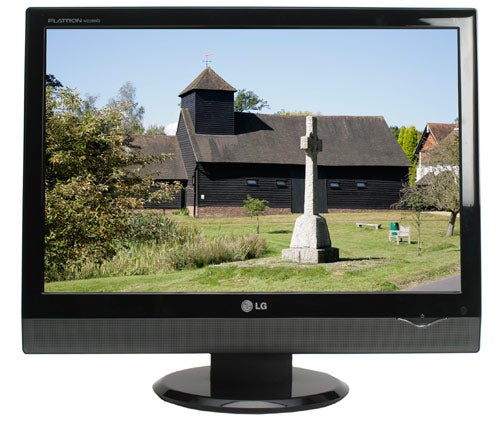
Verdict
Key Specifications
- Review Price: £250.00
In a stroke of quite uncanny foresight, only a week or so ago one of our forum members asked what the differences are between a TV and a monitor, besides the fact the former includes a TV tuner. Well, just as I’d posted a succinct little summary of some of the differences, what should turn up on my desk? None other than a monitor that includes a TV tuner, which once again proves you simply can’t know it all in this industry, no matter how hard you try.
In case you were wondering, the forum thread resides here. So if you fancy a bit more insight into the subject you may want to have a read. For the time being, though, I’ll jump away from this aside and get back to the task in hand – seeing how good the LG Flatron M228WD is. 
The M228WD, then, is a 22inch LCD monitor with a resolution of 1,680 x 1,050 that packs into its diminutive chassis a single digital TV tuner, a whole plethora of digital and analogue inputs, a couple of speakers, and a remote control, which is undeniably an impressive list of features. In fact, short of including TV recording facilities, there isn’t much more you could ask for from this monitor, or at least so it seems on the surface. As is often the case, squeezing this many features into a small space for such a low price means there are plenty of compromises when it comes to quality, whether it be of the picture, sound, or build variety. Before we delve too deep into these issues, though, let’s take a look a closer look at what the M228WD does have to offer.
Out the box, it makes a good first impression with its glossy black frame and under slung speaker grill giving it a suitably up-market TV-like appearance. The various logos dotted round the bezel are perhaps a little intrusive for a TV and the bright blue LED above the touch sensitive power switch could also prove distracting. However, altogether it’s an attractive package.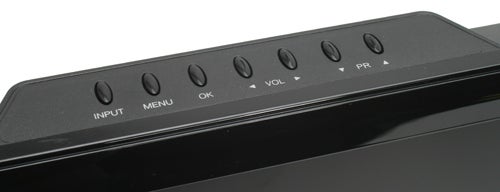
Also, like many modern TVs, the M228WD’s buttons are situated on the top of the screen, where they remain out of sight yet are easy to reach and, perhaps more importantly, read when needed. Given the inclusion of a built-in TV tuner, it’s no surprise to see four of said buttons are dedicated to volume and program adjustment, though these do also double up as the navigation buttons for the On Screen Display (OSD) – more on this later.
The first obvious money saving measure comes in the form of the stand as it offers only swivel and tilt adjustment – and pretty crummy tilt adjustment at that – which is below par for a screen costing this much. So if you’re of the lanky persuasion, like yours truly, the lack of height adjustment means you’ll have to resort to stacking a few books under your monitor to get it high enough to use comfortably. 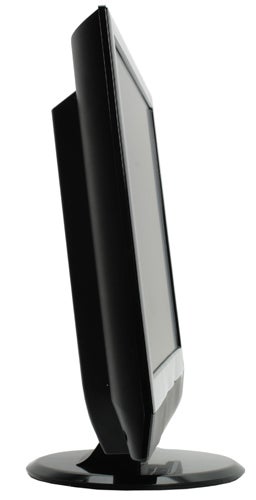
There’s also no portrait mode, which, even though you’d seldom view a TV in portrait, is something we always like to see on monitors because it makes plugging in cables much easier – just swivel the base ninety degrees and turn the screen to portrait and you can access all your connections. However, in fairness to LG, it has come up with a clever way round the cable plugging in problem, namely the various sockets on the back face outwards rather than downwards. This simple change means all that’s required to easily see and access the sockets is to swivel the base.
Speaking of inputs, as we alluded to earlier, the M228WD is positively brimming with connections. From the seemingly ancient SCART to the ultra-modern HDMI, and everything in-between, this monitor has it all, and then some. Just to spell it out for you, there’s one HDMI (with HDCP compliance, so it’s Blu-ray ready), two SCART, a set of Component video phono sockets with a pair of accompanying phono sockets for stereo audio, a 3.5mm auxiliary audio socket, and D-SUB/VGA. There’s also a CI slot for adding Top Up TV services, like Setanta Sports, and an RS232 serial port for updating firmware (for all those budding monitor engineers out there). 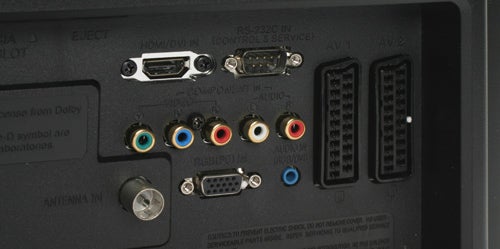
The keen eyed among you will notice there’s no DVI but rest assured this connection is also taken care of by a DVI to HDMI cable, which is included in the box. Of course, with many of the latest games consoles and set top boxes using HDMI, this does limit the number of other devices you can plug into the M228WD at once. However, for the price, it would be quite astounding to get more than one HDMI port.
An infra red remote is included for controlling the TV portion of the M228WDs features as well as navigating the OSD. In fact, it’s this latter feature that is probably my favourite of the whole device. Even considering how easy to use the buttons on the screen are, being able to sit back and use a remote with properly laid out arrow buttons to navigate the menus is infinitely preferable. 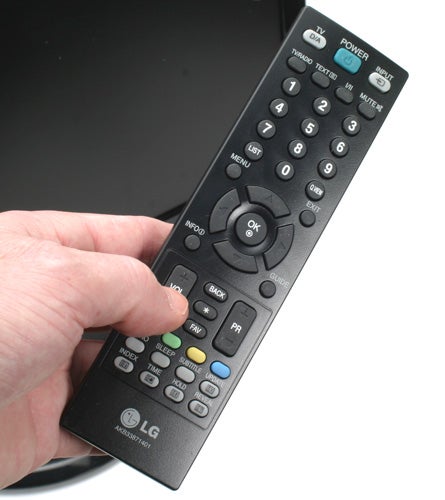
It’s not all about the OSD, though, as the rest of the remote is also well laid out with proper dedicated buttons for all the functions you’d expect for a TV remote, including EPG, teletext, and the all important red button. Sure, it looks a bit cheap with its rubbery buttons and lightweight plastic body, but all the buttons are responsive and it feels good in the hand.
The same ease of use is present when actually using the M228WD as a TV. Everything is easy to control, changing channels is very quick, and the EPG is comprehensive and easy to use. Moreover, all this is complemented by what has to be one of the best OSD’s I’ve seen on either a monitor or TV. Menus are well labelled, intuitively laid out and respond quickly to commands, making getting where you need and doing what you need incredibly quick and easy.
All the usual options are there including contrast, brightness and colour temperature settings. There’s also a selection of Picture Modes that are basically just profiles that contain values for all the other settings. You can choose from Dynamic, Standard, Mild, and one of two user profiles. The Standard and Mild modes essentially adjust contrast and brightness to give a brighter or more subdued image respectively, and the two user profiles enable you to create a couple of your own setups that you can recall at the touch of a button. The interesting one, though, is Dynamic, which uses LG’s Digital Fine Contrast (DFC) to dynamically adjust contrast during video playback. 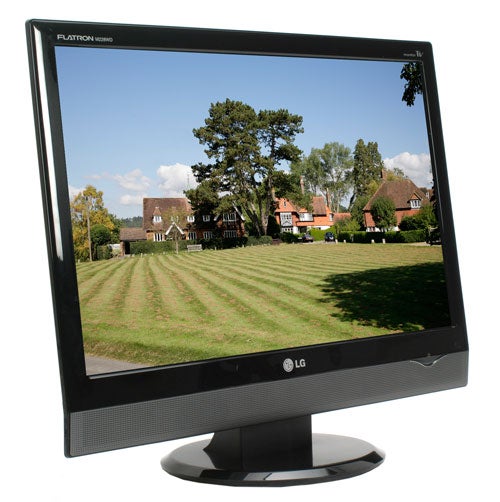
Now this isn’t a dynamic backlight adjustment, as seen on many newer LCD TVs, but rather DFC just digitally adjusts the signal to boost contrast. As a consequence of this, it doesn’t really seem to do much, or at least nothing of merit. If anything it just seems to saturate colours more so dark areas appear darker and light areas appear lighter. However, in doing so it loses detail in these areas and, perhaps even more concerning, compression artefacts in video are highlighted even more. Essentially, our advice would be to leave this setting off.
Of course, being a TV, the OSD has a whole host of other options for the tuner, including programme management (for renaming or removing channels from the channel list) and CI information. There’s also plenty of options for the inbuilt speakers, including a quite mind-boggling array of Sound Modes (Surround MAX, Standard, Music , Movie, Sports, User – we’d recommend sticking to standard) and the option to turn the speakers completely off.
Unfortunately, while the M228WDs features, ease of use, and performance are superb, the same can’t be said for its sound or image quality whether used as a TV or monitor.
First and foremost among the problems is the panel that is clearly of the 6-bit TN variety, so struggles to reproduce colours as well as more sophisticated panels. OK, it has a respectable response time of 5ms, so gaming won’t be a problem, but colours are rather dull and inaccurate and sharpness is also quite poor. Likewise, viewing angles are mediocre at best. In fairness, the overall picture is by no means awful, being on a par with other cheap 22inch models, and with a bit of manual tweaking the picture can be livened up a bit and there’s no obvious colour distortion at wide viewing angles. It’s just that on an image quality front, the M228WD doesn’t warrant any merit either.
It’s the same story when watching TV. The picture is fine for general watching and isn’t dramatically worse than many cheap TVs, but there’s no image enhancing features either – at least not ones that work – so signal noise and compression artefacts are all very obvious.
Firing up DisplayMate only served to highlight these issues with noticeable colour banding in the colour scale tests and compression in the Dark-Grey Scale and White-level tests. That said, the backlighting is nice and even with no obvious light bleed and colour uniformity is also spot on.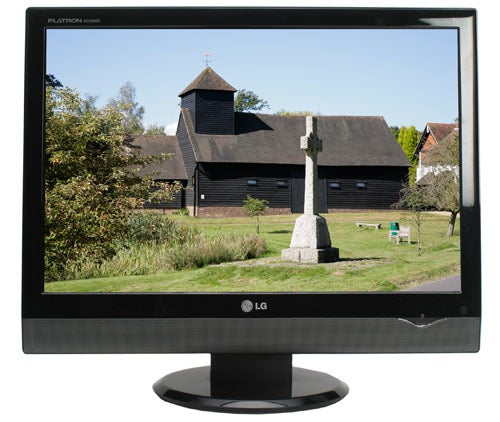
The final test was of sound quality and it is possibly here that the M228WD disappoints most. Not only is the sound thin and weedy but there’s also this horrible spacial effect whereby voices seem to come from somewhere behind the bottom left of the panel, rather than in the middle. This occurs no matter which Sound Mode you choose and it really is quite peculiar, and certainly not a pleasant listening experience.
So, on the one hand, the M228WD is a thoroughly feature packed TV/monitor that is a breath of fresh air in terms of usability, but on the other it has the sort of image and sound quality we’d normally expect from a model costing maybe £150, not £250. The question is whether all those extras are worth the price premium or are you better off spending all the money on a decent TV or monitor. Of course, if you only have £250 and you require both a TV and monitor because you need the extra connections and remote then the M228WDs features have surely got to tip the balance in its favour. If however, you could make do with just a monitor for the time being then I’d recommend you get a better quality one and grab a TV card for your computer.
”’Verdict”’
The LG Flatron M228WD combines a class leading feature set with great usability and connectivity to create a seemingly perfect TV/monitor combination. Unfortunately, it’s let down by mediocre image quality and poor sound so we’d only recommend it to those who really are pushed for space and need the extra connections. If you don’t need all the extra connections, though, you’d be better off buying a better quality monitor and a TV card for your computer.
How we test televisions
We test every TV we review thoroughly over an extended period of time. We use industry standard tests to compare features properly. We’ll always tell you what we find. We never, ever, accept money to review a product.
Trusted Score
Score in detail
-
Image Quality 6
-
Value 7

